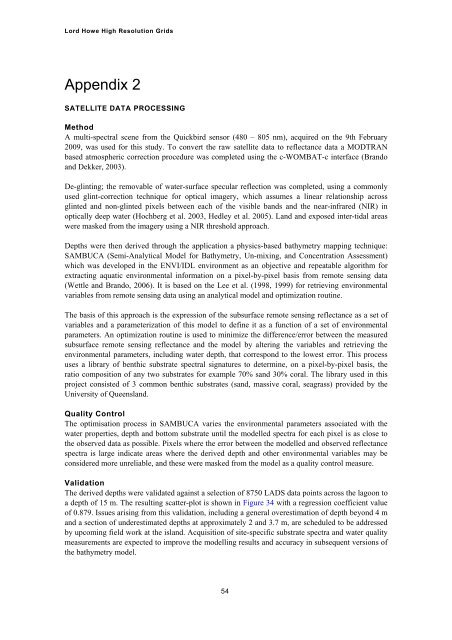Document Title - Geoscience Australia
Document Title - Geoscience Australia
Document Title - Geoscience Australia
Create successful ePaper yourself
Turn your PDF publications into a flip-book with our unique Google optimized e-Paper software.
Lord Howe High Resolution Grids<br />
Appendix 2<br />
SATELLITE DATA PROCESSING<br />
Method<br />
A multi-spectral scene from the Quickbird sensor (480 – 805 nm), acquired on the 9th February<br />
2009, was used for this study. To convert the raw satellite data to reflectance data a MODTRAN<br />
based atmospheric correction procedure was completed using the c-WOMBAT-c interface (Brando<br />
and Dekker, 2003).<br />
De-glinting; the removable of water-surface specular reflection was completed, using a commonly<br />
used glint-correction technique for optical imagery, which assumes a linear relationship across<br />
glinted and non-glinted pixels between each of the visible bands and the near-infrared (NIR) in<br />
optically deep water (Hochberg et al. 2003, Hedley et al. 2005). Land and exposed inter-tidal areas<br />
were masked from the imagery using a NIR threshold approach.<br />
Depths were then derived through the application a physics-based bathymetry mapping technique:<br />
SAMBUCA (Semi-Analytical Model for Bathymetry, Un-mixing, and Concentration Assessment)<br />
which was developed in the ENVI/IDL environment as an objective and repeatable algorithm for<br />
extracting aquatic environmental information on a pixel-by-pixel basis from remote sensing data<br />
(Wettle and Brando, 2006). It is based on the Lee et al. (1998, 1999) for retrieving environmental<br />
variables from remote sensing data using an analytical model and optimization routine.<br />
The basis of this approach is the expression of the subsurface remote sensing reflectance as a set of<br />
variables and a parameterization of this model to define it as a function of a set of environmental<br />
parameters. An optimization routine is used to minimize the difference/error between the measured<br />
subsurface remote sensing reflectance and the model by altering the variables and retrieving the<br />
environmental parameters, including water depth, that correspond to the lowest error. This process<br />
uses a library of benthic substrate spectral signatures to determine, on a pixel-by-pixel basis, the<br />
ratio composition of any two substrates for example 70% sand 30% coral. The library used in this<br />
project consisted of 3 common benthic substrates (sand, massive coral, seagrass) provided by the<br />
University of Queensland.<br />
Quality Control<br />
The optimisation process in SAMBUCA varies the environmental parameters associated with the<br />
water properties, depth and bottom substrate until the modelled spectra for each pixel is as close to<br />
the observed data as possible. Pixels where the error between the modelled and observed reflectance<br />
spectra is large indicate areas where the derived depth and other environmental variables may be<br />
considered more unreliable, and these were masked from the model as a quality control measure.<br />
Validation<br />
The derived depths were validated against a selection of 8750 LADS data points across the lagoon to<br />
a depth of 15 m. The resulting scatter-plot is shown in Figure 34 with a regression coefficient value<br />
of 0.879. Issues arising from this validation, including a general overestimation of depth beyond 4 m<br />
and a section of underestimated depths at approximately 2 and 3.7 m, are scheduled to be addressed<br />
by upcoming field work at the island. Acquisition of site-specific substrate spectra and water quality<br />
measurements are expected to improve the modelling results and accuracy in subsequent versions of<br />
the bathymetry model.<br />
54

















